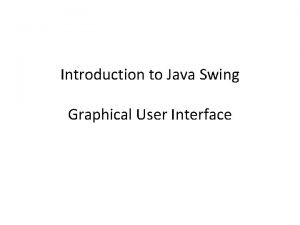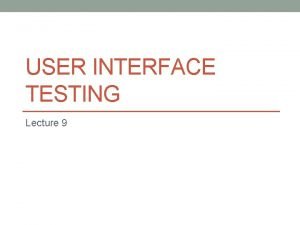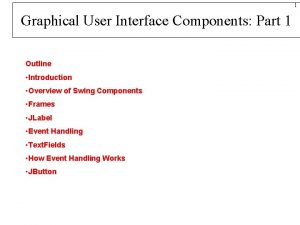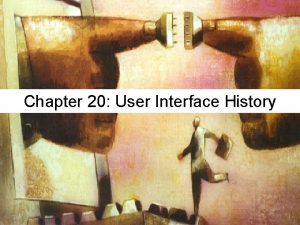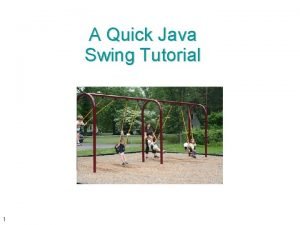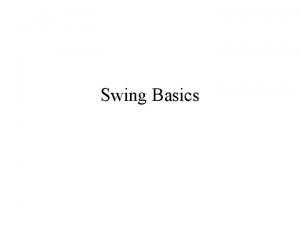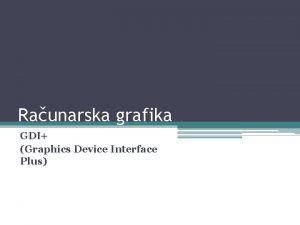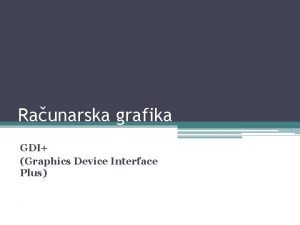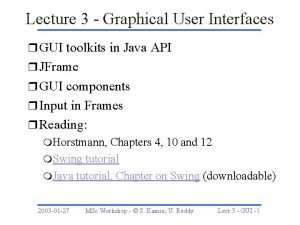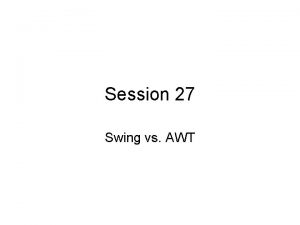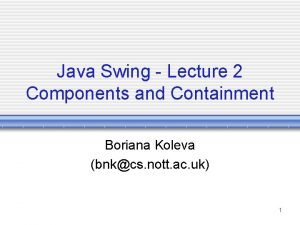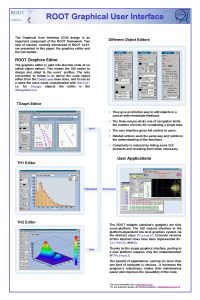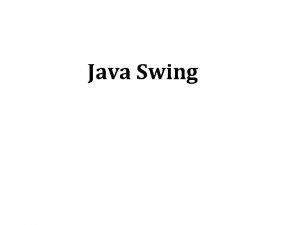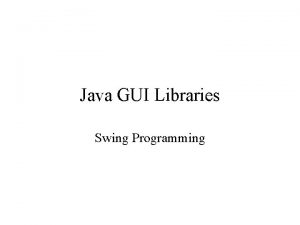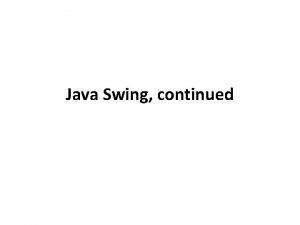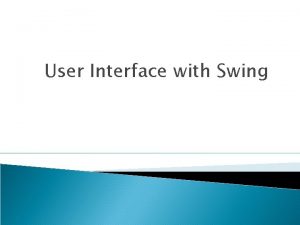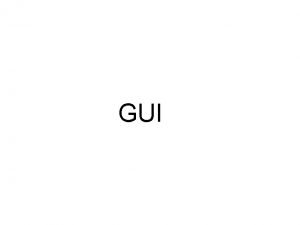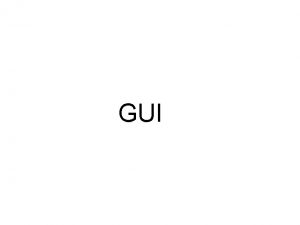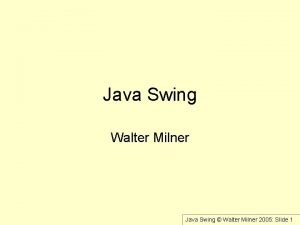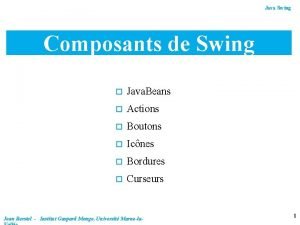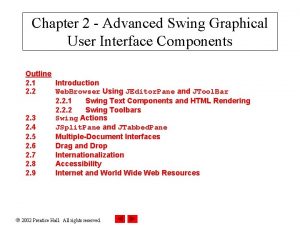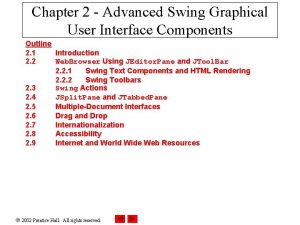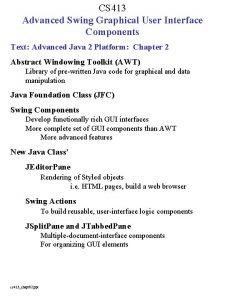Introduction to Java Swing Graphical User Interface Two

























- Slides: 25

Introduction to Java Swing Graphical User Interface

Two Types of Applications Console Applications: • Input from keyboard using java. util. Scanner • Output is usually displayed to a console window using System. out. print(). • Not practical for real-world GUI Applications • Graphical User Interface • Very practical for real-world

What is Java Swing? • Java Swing is a framework for developing Java GUI Apps. • Graphical functionality is provided by the library. There is no need to write your own. Note: Java 7: Uses Swing (current applications still use it. ) Java 8+: Java. FX

Topics • Swing Components JFrame JComponent JPanel User Interface (UI) components: buttons, text fields, labels, etc. • Action Events • Building a Fractal drawing application.

Swing Components • Swing is a toolkit that Sun Microsystems created to enable large-scale java applications. • Swing provides a wide array of visual and interactive components. • All Swing component names begin with "J"

JFrame • The graphical window for an application. • JFrame provides a top-level window with a title, border. • JFrame is a container component. • User Interface components can be easily added to a JFrame.

JFrame Example The application window shown below is a JFrame. Buttons, text input fields, and a graphic component have been added to the JFrame.

JComponent • This is a container class. • j. Component also provides functionality for painting and drawing.

Jcomponent Example: . A JComponent element was added to the Jframe. Rectangles were drawn on the JComponent.

Common UI Components • JButton : This is a typical button. Buttons can react to an action event. • JText. Field: This is a standard input text box for the input of a single line of text. A JText. Field can react to input events. • JLabel: Used to label a nearby action component. Labels do not react to action events or input events.


Action. Event Handling • UIComponents, such as a Jbutton, fire off Action. Events to indicate some kind of action has occurred. For example, a JButton fires off an Action. Event whenever the user presses it. • To respond to an Action. Event, an action listener must be attached to the UI component. • An event listener is triggered when an action event occurs. • action event can be registered to many UI components.

Handling Events • Clicking a button on the interface is an example of an event. When an event occurs, there are three objects that must be involved: 1. The object causing the event, the event source, such as a button. 2. An object representing the event, the Action. Event. 3. The object that listens for and then handles a triggered event, the Action. Listener.

The Action. Listener object provides a method called action. Performed that accepts an Action. Event argument.

a. b. c. Example: A button is created. An Action. Listener is instantiated and registered to the button. When a button click event occurs, the action. Performed () method will respond. private void create. Button() { button = new JButton("Create Rectangles"); Action. Listener listener = new Add. My. Listener(); button. add. Action. Listener(listener); } class Add. My. Listener implements Action. Listener { public void action. Performed(Action. Event event) { //DRAW ON ADRAWING COMPONENT Draw. Component. create. Rectangle(); } }

Build the Fractal Generator App


App Structure Design uses a MVC Architecture

Build the App from the Bottom Up! • • Fractal. java C_curve. Component C-curve. Frame My. App

import java. awt. Graphics; Fractal. java public class Fractal { public void draw. CCurve(Graphics g, int x 1, int y 1, int x 2, int y 2, int level) { //PRIMITIVE STATE: DRAWS A STRAIGHT LINE FROM X 1, Y 1 TO X 2, Y 2 if (level == 1){ g. draw. Line(x 1, y 1, x 2, y 2); } //RECURSIVE ELEMENT: TWO LINES WILL BE PRODUCED FOR EVERY SINGLE LINE else { int xn = (x 1 + x 2) / 2 + (y 1 - y 2) / 2; int yn = (x 2 - x 1) / 2 + (y 1 + y 2) / 2; draw. CCurve(g, x 1, y 1, xn, yn, level - 1); draw. CCurve(g, xn, yn, x 2, y 2, level - 1); } } }

public class C_curve. Component extends JComponent { private Fractal fractal; private int level; private int x 1, y 1, x 2, y 2; public C_curve. Component() { C-curve. Component. java level = 2; fractal = new Fractal(); } public void set. XY(int _x 1, int _y 1, int _x 2, int _y 2) { x 1 = _x 1; y 1 = _y 1; x 2 = _x 2; y 2 = _y 2; } public void set. Level(int _level){ level = _level; } public void create. Ccurve() { repaint(); } public void paint. Component(Graphics g) { fractal. draw. CCurve(g, x 1, y 1, x 2, y 2, level); } }

public class C_curve. Frame extends JFrame { private JPanel panel; C-curve. Frame. java private JLabel level. Label; private JText. Field level. Field; private JButton button; private C_curve. Component c. Curve. Draw. Component; public C_curve. Frame() { // TASK : BUILD THE PANEL ELEMENTS this. set. Size(700, 700); //WINDOW SIZE panel = new JPanel(); level. Label = new JLabel("Level: "); level. Field = new JText. Field(10); //FIELD WIDTH OF 10 level. Field. set. Text("" + 2); //INITIALIZE THE TEXT FIELD TO 2 button = new JButton("Create C-curve"); panel. add(level. Label); panel. add(level. Field); panel. add(button); c. Curve. Draw. Component = new C_curve. Component(); c. Curve. Draw. Component. set. Preferred. Size(new Dimension(700, 700)); c. Curve. Draw. Component. set. Level(2); //2 is the default level panel. add(c. Curve. Draw. Component);

C-curve. Frame. java // TASK : ADD THE COMPLETED PANEL TO THE FRAME WINDOW this. add(panel); } // TASK : REGISTER AN ACTION LISTENER FOR THE BUTTON Action. Listener listener = new Add. My. Listener(); button. add. Action. Listener(listener);

class Add. My. Listener implements Action. Listener { public void action. Performed(Action. Event event) { //TASK 1: GET THE FRACTAL LEVEL INPUT BY THE USER int level = Integer. parse. Int(level. Field. get. Text()); c. Curve. Draw. Component. set. Level(level); //TASK 2: COMPUTE THE STARTING AND ENDING XY COORDINATES int frame_width = 700; int frame_height = 700; int x 1 = frame_width / 4; C-curve. Frame. java int y 1 = frame_height / 3; int x 2 = frame_width - x 1; int y 2 = y 1; //TASK 3: SET THE XY START AND END FOR THE DRAWING COMPONENT c. Curve. Draw. Component. set. XY(x 1, y 1, x 2, y 2); } } } //TASK 4: CREATE THE CURVE ON THE DRAWING COMPONENT c. Curve. Draw. Component. create. Ccurve();

My. App. java import javax. swing. JFrame; public class My. App { public static void main(String[] args) { JFrame frame = new C_curve. Frame(); frame. set. Default. Close. Operation(JFrame. EXIT_ON_CLOSE); frame. set. Visible(true); } }
 Java user interface
Java user interface Introduction of gui
Introduction of gui Graphical user interface testing
Graphical user interface testing Principle of input design
Principle of input design Graphical user interface design principles
Graphical user interface design principles Graphical user interface history
Graphical user interface history Characteristics of graphical and web user interface
Characteristics of graphical and web user interface Graphical user interface testing tools
Graphical user interface testing tools Characteristics of graphical user interface
Characteristics of graphical user interface Graphical user interface in data structures
Graphical user interface in data structures Components of graphical user interface
Components of graphical user interface Web user interfaces
Web user interfaces Graphical user interface history
Graphical user interface history Pengertian awt dan swing pada java
Pengertian awt dan swing pada java Interface in interface java
Interface in interface java Java swing tutorial
Java swing tutorial Classes salsa and swing implement an interface dance
Classes salsa and swing implement an interface dance Metasploit graphical interface
Metasploit graphical interface Graphical device interface with c
Graphical device interface with c Snort front end
Snort front end Graphical device interface with c
Graphical device interface with c Ruby graphical interface
Ruby graphical interface Java gui for r
Java gui for r Java swing vs awt
Java swing vs awt Java swing responsive
Java swing responsive Java swing container
Java swing container
